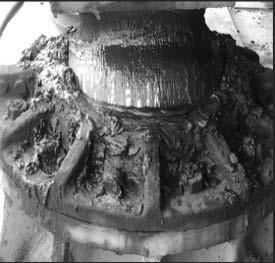
15 minute read
Lubrication in Mining Equipment
Lubrication in
Mining Equipment
Ashok Kumar Goyal, Rohit Agarwal, Balaram Ghosh and Abhijit Roy
Balmer Lawrie & Co. Ltd., Applications Research Laboratory, P-43, Hide Road Extn, Kolkata, India – 700 088.
Abstract
Mining industry deploys a large number of heavy earth moving equipment like draglines, shovels, dumpers and dozers for the extraction of minerals and coals via surface or underground mining. Effective lubrication to protect the heavily loaded components of mining equipment is a key responsibility of the users, lubricant manufactures and original equipment manufacturers (OEMs). The number of breakdown arise due to failure of lubricating components can be reduced by maintaining proper lubrication on production equipment. Dispensing of right lubricant, in right quantity at right time is very crucial to prevent the system failure. Designing of right lubricant for different components of mining equipment viz. enclosed gear drives, open gear drives, different types of bearings, circulating and hydraulic components, is a challenging task for lubricant manufacturers. Present paper elaborates on various criteria & considerations for the development of appropriate lubricants for different components of mining equipment especially for draglines and shovels.
Introduction
Maintenance of production equipment in mining industry is very essential to keep the equipment in efficient working condition to increase the productivity by reducing downtime. Maintenance people seek to reduce the maintenance costs, increase equipment utilization and improve equipment reliability. To achieve this, maintenance personal often look to upgrade the lubricants to the latest technology.
Primary function of any lubricant is to reduce the friction which is normally achieved by introducing an ideal film of oil or sufficient amount of grease between two surfaces in relative motion. This lubricant film prevents the two surfaces to come in contact under the conditions of speed and load imposed on the moving parts. In the absence of proper lubrication machine parts develop friction, heat and rapid wear, which may eventually cause machine failure. Improper lubrication also results in frequent downtime, higher operating cost due to lower efficiency. Some of the direct costs resulting from improper lubrication include cost of replacement spares and components, labor for replacements and repair, excess lubricant consumption and labour for inefficient manual lubrication practice. Therefore proper lubrication of each lubricating surface of production equipment is very essential for the smooth operation of any industry.
Present paper elaborates about the development of appropriate grease lubricants for different lubricating surfaces of mining draglines and shovels. For the development of suitable grease lubricants mode of application, various tribological aspects and original equipment manufacturers (OEM) recommendations related to lubricants are also taken into consideration.
Mode of Lubrication
Lubricants can be applied on lubricating surfaces by manual or automatic lubrication methods.
The main difference between manual and automatic lubrication is that in the case of manual mode, technicians tend to lubricate on schedule (once a day, week, month, year, etc.) rather than when the lubricating surface needs it. This sets up an over lubrication or an under lubrication scenario (Figure 1). Conversely, automated lubrication provides lubricant constantly at an appropriate amount that allows the lubricating component to operate at its optimum. When the lubricating surface is properly lubricated in this manner, it also helps to seal from contaminants. In addition, there is less downtime compared to the manual lubrication process, as well as substantially reduced man-hours required for the task. It is possible with automated lubrication system to lubricate machine parts while the machine is in operation and also the machine parts which are inaccessible or difficult to access manually can be easily lubricated with automated lubrication system. However it is very important to maintain the automated lubrication system in proper working condition.
Tribological aspects of lubrication
Lubricants are continuously improved over the years to take care of the modern machines running hotter, faster and longer. Today’s lubricants must satisfy extreme requirements that are specific to each application. Type of motion, speed, temperatures, load and the operating environment are certain tribological aspects which have to be identified before the development of any lubricant. Once these tribological aspects are identified, the lubrication engineer can utilize different lubricant chemistry to design a lubricant that will optimize the performance of the application.
Type of Motion
The first parameter of the tribological aspect involves the type of motion. The motion may be sliding or rolling. Combined sliding and rolling is also a possible form of motion in certain rolling-element bearings including the tapered roller bearing. Protection of machine components under these types of motion can be optimized with specific chemistry. Some specific chemistry is more effective in sliding contacts than in rolling contacts. Combination of synergistic additive system is required for motions which involve both sliding and rolling contacts.
Speed of moving components can be categorized into the general ranges of fast, moderate and slow. Knowing the speed of the contact, a lubricant can be selected with the optimum physical attributes to minimize friction. In general, for higher speed applications lubricants should be with lower viscosity and for lower or moderate speed applications, lubricant should be designed with medium to higher viscosity.
Temperature
All lubricants have specific temperature ranges for optimal performance. Many lubricants have a broad operational temperature range however, some lubricants are more suited for lower temperatures. For example, there are some greases with low viscosity synthetic hydrocarbon base oil can operate at temperatures as low as -60°C. Other lubricants are designed for high temperature applications, such as greases with high viscosity synthetic hydrocarbon base oil thickened with Calcium Sulphonate Complex soap that can lubricate an oven chain bearing at 220°C. Knowing the application temperature the lubricant manufacturer should develop the lubricants which can provide optimum performance at the application temperature.
Load
Load is an important factor affecting the lubricant requirement. A light load may indicate that application is sensitive to frictional torque and therefore a lubricant with low viscosity should be designed to minimize the fluid friction while still providing adequate protection from friction and wear. For heavily loaded application, a high viscosity lubricant is required with specific extreme pressure additives to protect the machine parts from pitting, galling and extreme wear. Therefore, for heavily loaded applications lubricants should be formulated with high extreme pressure and anti-wear additives.
Operating Environment
If the environment includes moisture or water, the lubricant must provide good anticorrosion properties as well as resistance to water washout. If the application involves the presence of certain chemical liquids or vapors, the lubricant must be resistant to these chemicals.
Many applications have special requirements that go beyond the tribological aspects that must be taken into consideration. Lubricant development is also dependent on certain specialized requirements i.e. Lubrication equipment, re-lubrication intervals, cost, special certifications such as DGMS approval, biodegradability etc. Therefore, by identifying various tribological aspects a lubrication engineer (or tribo-engineer) can design proper lubricant for different lubricating surfaces of any machine.
Lubrication in Mining Draglines and Shovels
Big, bigger and biggest are the standards in Mining. Draglines and Shovels are of prehistoric sizes and their gears and other lubricating parts are amongst the largest applied anywhere. In both closed and open systems a variety of different lubricants are being used. Extreme pressure protection, reliability, consistency and performance in dusty environment are key factors for the development of correct lubricant for different moving surfaces of the mining equipment.
Lubrication in Swing Gear and Swing Rack Gear system
During the operation of draglines and shovels the whole upper body of the machine can be swing in each direction on lower base body with the help of swing gears (Figure 2). In draglines the swing gear is composed of swing pinion shaft, swing pinions & swing rack gears and swing circle rollers & roller path, which is known as swing rack gear system.
Swing Pinion Shaft: This is a large shaft which is mounted below the swing gear box and at base of which is mounted the swing pinion. The shaft is supported by anti-friction bearings which are lubricated with grease.
Swing Pinions & Rack Gears: These are located in the sub-floor of dragline. Depending on the size and age of machine the no. of these may be between 4 to 8 pinions. The swing rack is always internally geared & the gear is made up of segments that are bolted to the tub frame. The swing rack and pinions are lubricated with open gear compounds. Method of lubricant application is normally by spray where grease is delivered via injectors and atomized by air.
Swing Rollers & Roller Path: At upper rotating deck & lower frame of the machine in between two large bearing raceways (roller paths) a series of parallel face rollers contained within a cage is positioned. The path and outer surface of the rollers are lubricated with open gear compound that is usually applied via drip feed from pipes connected to grease injectors. The rollers have centre bearings to support each roller and these bearings are lubricated with grease, which can be applied manually, or via single point lubricators.
Usually lubrication in swing rollers is provided by automated pumping system and in swing rack gear system by automatic spray system. In case of failure of automated lubrication system, lubrication can be carried out manually by maintaining proper amount and frequency of re-lubrication. Swing rack gear system and swing rollers work under tremendously high load and low speed conditions. The lubricant used for swing rack gear system should create a tenacious / tacky film which resists breakdown and wiping under high load conditions. The lubricant should be based on very high base oil viscosity and fortified with extreme pressure additives, anti-wear additives and solid lubricants, to provide adequate protection to the heavily loaded open gears and extend the component life while reducing consumption. The lubricant should also have water resistance property to prevent the lubricant from being washed off in rainy season.
Development of Grease Compound 1
By considering the mode of applications, working conditions and environmental effects along with OEM specifications of swing gear lubricants for shovels and draglines, grease compound 1 has been developed. This grease is suitable for lubrication of all types of large and small open gears working under heavy loads and prone to excessive pitting, scaling or abrasive wear. This compound is right lubricant for typical applications including swing rack gear and pinion, swing rollers, hoist and drag gear system of draglines, swing gear and pinion and hoist gear system of shovels. This compound is highly water resistance even in rainy season and easily can be applied on lubricating surfaces either by automatic lubrication system or by manual method. Grease compound 1 can easily be applied even in cold season as compared to bituminous lubricants which becomes
very stiff in cold climatic conditions. The performance of this grease compound was found excellent in terms of easy application, less consumption and less maintenance requirement. The properties of Grease Compound 1 are given in Table 1.
Lubrication in Hoist and Drag gear & pinion
The conventional dragline hoist drum has two hoist ropes that run in unison and are both connected to the bucket rigging at the same attachment point (Figure 3). Hoist and drag drum run independently to each other in both direction and speed up by enclosed gearpinions. Lubrication of these enclosed gear-pinions is carried out by manual or automated lubricant pumping system. Heavy duty grease compound 1 developed for swing rack gear system and swing gears also gives excellent performance when used in hoist and drag gear pinions of draglines.

Lubrication on Hoist, Drag and Dump Wire Ropes
The ropes are made up of many strands and configurations to cope with continuous movement as load is applied & released and also as the rope bends over sheaves during use. Wire ropes are made of high carbon steel wires that have been cold drawn, producing very ductile, fatigue resistance properties, as well as very high strength. The rope life can be reduced from 40-50 % if the ropes are not lubricated beyond what was applied during rope making. Inadequate lubrication could also seriously impact on the wear of the sheaves and drums. The type of lubricant used and means of lubricant application can also have a significant impact on the rope life. Therefore, hoist, drag and dump wire ropes should be lubricated properly to extend their service life.
Ropes are lubricated as they pass over deflection rollers and through sheaves. The most common method of rope lubrication is drip tubes or spray nozzles, through some sites use pressurised applicators that straddle the rope as it passes through the application. Rope lubricant should be designed with low viscosity oils to adequately penetrate the strands (wires) of rope which can prevent internal wear as well as higher viscosity base fluids are required to prevent the external wear. For lubrication at external surfaces, oil thickened with soaps or non-metallic thickeners are beneficial. Rope lubricants are usually fortified with extreme pressure additives and may contain plus a low percentage (typically 3 %) of lubricating solid additives.
Development of Grease Compound 2
Taking in consideration both internal and external wear of wire ropes grease compound 2 has been developed which is based on moderate base oil viscosity along with highly water resistance soap thickener. Grease compound 2 is semi-fluid, tacky and specially suited for in-service lubrication of wire ropes under varying services. It contains a performance enhancing additive combination to offer protection of individual wire strands against friction, wear, and corrosion. It gives excellent performance for in-service lubrication and corrosion protection of wire ropes continuously exposed to atmosphere and for wire ropes requiring protection against varying climatic and environmental conditions. Grease compound 2 contains a highly water resistant soap base to provide excellent corrosion/ rust preventive characteristics. It is extremely tacky. Hence it does not sag out of the surfaces, adheres well on the surface of the wire ropes and resists throw-off during the service of the wire rope to offer extended protection. Its semi-fluid nature makes it easy to apply on the wire rope by drip tubes or by brush. Due to its moderate base oil viscosity it has the ability to penetrate between the individual strands and the inner core of the wire rope and also provide better lubrication at outer surface because of tacky and water resistance soap. Due to the presence of anti-corrosion additive it protects the wire strands and wire core as a whole against varying climatic conditions from rusting. Its operating temperature range is -10° C to + 80° C. Properties of grease compound 2 are shown in Table 2.
Most of the draglines have a walking mechanism which consists of an eccentric articulated arm, which is supported by a shaft and bearings on both sides (Figure 4). A link between the walking arm and the main frame stabilizes the eccentric motion. Lubrication of these parts can be carried out by
using greases with extreme pressure properties along with very good mechanical shear stability and water resistance properties.
Development of Grease Compound 3
Grease compound 3 especially designed for walking cam which has high base oil viscosity and fulfils the boundary film lubrication conditions under the harshest loads found on a dragline. This is suitable lubricant for this type of application which is formulated with extreme pressure additives for lubrication under severe mechanical conditions and for extension of lubrication frequency. Lubrication by these grease results in significant reduction in wear and coefficient of friction of mating surfaces. This grease is fortified with solid lubricants and has good surface adherence property to give excellent protection against rust, corrosion, water washout and has excellent film strength. This grease is also recommended for all types of bearings operating under heavy loads, shock loads or under excessively wet/ damp conditions. Properties of Grease compound 3 are shown in Table 3.
References

1. “Open Gear Lubricants for Cat Electric Rope
Shovels and Draglines”, www.cat.com. 2. M. Ian, “Dragline Lubrication”, Dragline Mining:
Prospectus & Challenges, 217-230, 2013. 3. K. Sherwood and W. Scott, “Improved Lubrication of Dragline Components”, 1996. 4. B. T. Jones, “Dragline Maintenance Engineering”, 2007. 5. D. Lauer, “Tribology: the Key to Proper Lubricant
Selection”, Machienary Lubrication, 3, 2008.
Conclusions
Grease compounds developed for different lubricating parts of draglines and shovels are found to be appropriate lubricants in terms of ease of application, less consumption and less maintenance requirements. Grease compound 1 gives a perfect solution for any type of swing gears which works under tremendously high load conditions by moving with low speed. Grease compound 2 is provides excellent performance by preventing both internal and external wear of wire ropes. Grease compound 3 gives better lubrication in eccentric cam & walking boot along with all types of bearings positioned in the machine.
Acknowledgements
The authors are sincerely thankful to the Management of M/s. Balmer Lawrie & Co. Ltd. for giving an opportunity to present the above work.
Table 1: Properties of grease compound 1
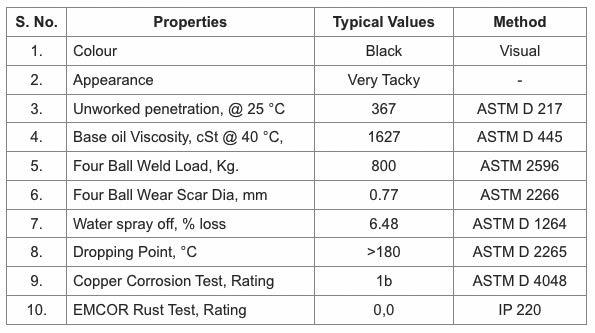

Table 3: Properties of grease compound 3
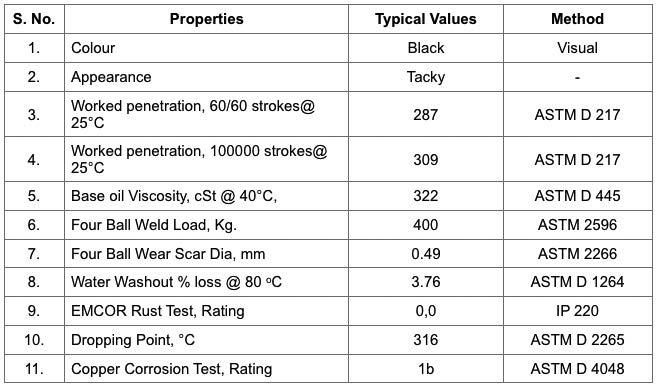
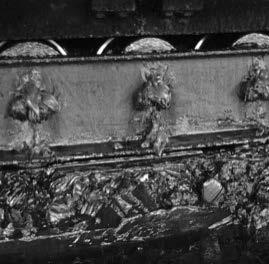
1a 1b
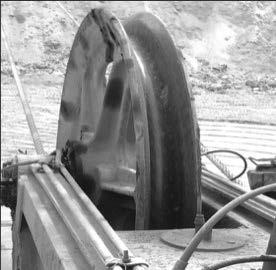
Figure 1: Lubrication Scenario: (1a) Over Lubrication and (1b) Under Lubrication.
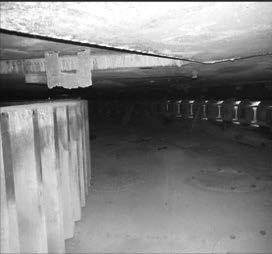
2a
2b Figure 2: Lubrication in swing gear system (a) Internal view of swing Rack gears along with swing rollers of dragline (b) Swing gear of electric rope shovel.
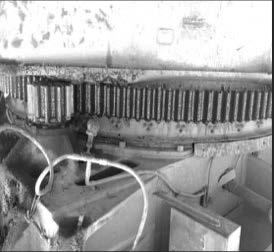
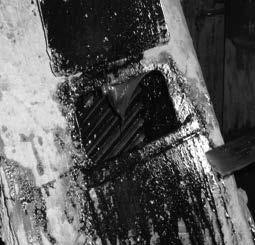
3a
3b Figure 3: Lubrication in Hoist and Drag gear & Pinions (a) Lubrication in enclosed hoist gear box (b) Open hoist gear of dragline.
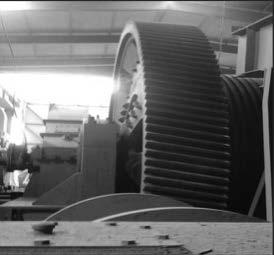
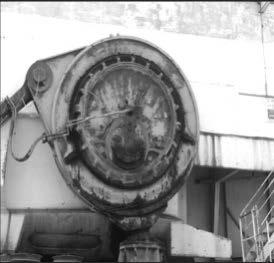
4a
4b Figure 4: Lubrication in (a) Eccentric Cam and in (b) Ball of walking boot of dragline
